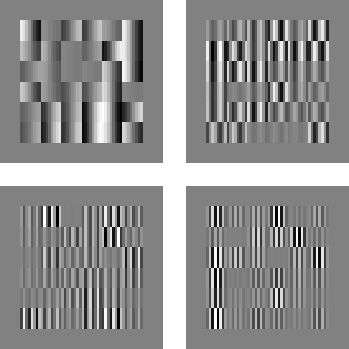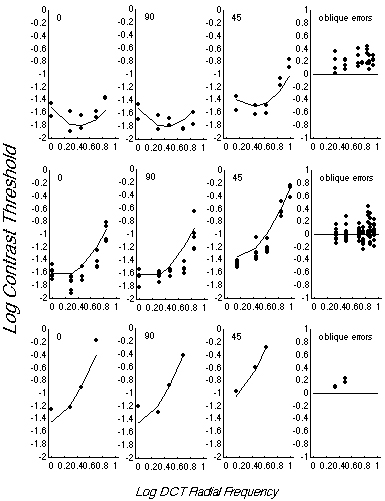|
|
 |

|
 |
 |
| Visibility of DCT Noise (Andrew B. Watson & Albert J. Ahumada, Jr.) |
 |
Overview
Space exploration programs will always generate immense quantities of image data. For example, the Earth Observing System (EOS) was expected to generate in excess of one terabyte/day. NASA Vision Group researchers confronted a major technical challenge in managing this great flow of imagery: in collection, pre-processing, transmission to earth, archiving, and distribution to scientists at remote locations. Expected requirements in most of these areas clearly exceed current technology. Part of the solution to this problem was the creation of efficient image compression techniques.
The Discrete Cosine Transform (DCT) is the basis of a widely-used compression technique, and underlies several emerging international standards for image compression. The artifacts generated by this technique are samples of DCT quantization noise. DCT quantization noise can be produced by uniform random perturbation of each DCT coefficient in each block of an otherwise uniform grey image. A sample of this noise consists of an array of blocks, within each of which each DCT basis function has a random amplitude within some range. The ranges of all frequencies except one may be set to zero to produce noise of only a single DCT frequency (see Fig. 1). The visual quality and fidelity of the compressed imagery depends upon the visibility of this noise. As part of our larger effort (conducted in collaboration with IBM) to apply modern, model-based human factors principles to DCT based compression, we have measured the visibility of DCT quantization noise.
In particular, we have studied the effects of spatial frequency, display resolution, spatial summation, frequency summation, and contrast masking. Fig. 2 shows the effect of spatial frequency upon DCT noise visibility. Other results show that visibility increases as the fourth root of the number of basis functions (image size), and that contrast masking extends over more than an octave of DCT frequency. Display resolution influences visibility in ways that are largely predictable from image size and spatial frequency. We have incorporated the results into our mathematical model of visibility of DCT compression artifacts. These results will allow systematic perceptual optimization of image compression in NASA imaging systems.

Figure 1. The figure shows four examples of DCT quantization noise. Each is a 6x6 array of basis functions with uniformly distributed amplitudes. The DCT frequencies of the four eaxmples are (0,1), (0,3), (0,5) and (0,7).

Figure 2. The figure shows measurements of log visibility of DCT basis functions for five observers at a display resolutions of 16 (top), 32 (middle) and 64 (bottom) pixels/degree, as a function of the radial spatial frequency of the basis function. Data are plotted separately for vertical, horizontal, 45 degree, and oblique basis functions. The curves in the three leftmost columns shows the best-fitting model; in the fourth panel departures from the model are shown for the oblique frequencies only.
Contact
Albert J. Ahumada, Jr.
(650) 604-6257
Albert.J.Ahumada@nasa.gov |
|
|
|
|